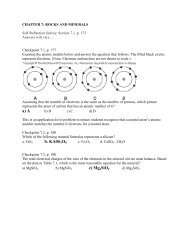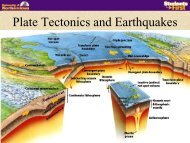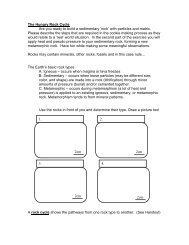Study Guide for Intro. to Geology (Heinzel)
Study Guide for Intro. to Geology (Heinzel)
Study Guide for Intro. to Geology (Heinzel)
Create successful ePaper yourself
Turn your PDF publications into a flip-book with our unique Google optimized e-Paper software.
<strong>Study</strong> <strong>Guide</strong> <strong>for</strong> <strong>Intro</strong>. <strong>to</strong> <strong>Geology</strong><br />
(<strong>Heinzel</strong>)<br />
Exam One – Wednesday, September 28, 2011<br />
This document does not state everything that may appear on the exam, it is<br />
merely a starting point. If you want <strong>to</strong> do well on this exam study, learn not<br />
memorize the material, and ask a lot questions.<br />
When studying <strong>for</strong> the exam use<br />
1. Your lecture notes<br />
2. The pictures, graphs, drawings, etc. from our lectures<br />
www.uni.edu/cheinzel Tabs = Teaching & <strong>Intro</strong>. <strong>to</strong> <strong>Geology</strong><br />
3. The chapter readings<br />
Chapters <strong>for</strong> Exam 1 include:<br />
The Prelude: What is geology?<br />
Our island in space: Ch. 2<br />
Earth His<strong>to</strong>ry: Chs.12 and 13<br />
Minerals: Ch. 5<br />
Igneous Rock: Ch. 6<br />
Sedimentary Rock, Weathering, & Soil: Ch. 7<br />
Metamorphic Rock: Ch. 8<br />
Remember you will NOT have <strong>to</strong> identify any hand samples of minerals or<br />
rocks during this first lecture exam. We will do that in Lab.<br />
I guarantee that the rock cycle (first handout) WILL be on the exam! Do not<br />
just memorize it learn how one rock type can change in<strong>to</strong> another rock<br />
type!<br />
If you understand and can apply the BIG IDEAs of our lectures and the<br />
text’s TAKE HOME messages you should do well on this exam!<br />
Approx. 100 points (multiple choice, fill-in-the-blank, and short answer)
Examples of Lecture Highlights: Don’t <strong>for</strong>get the BIG IDEAS we have talked<br />
about!!!<br />
Prelude:<br />
A. Types of Geologists (what the sub disciplines do and how they help<br />
society) E.g. Hydrogeologist – studies and protects groundwater resources<br />
B. The MAJOR themes of <strong>Geology</strong> and this Class… (pages 5-7)<br />
C. Why study geology?<br />
Earth His<strong>to</strong>ry (Ch. 12 and 13)<br />
A. The Earth’s age<br />
B. Relative vs. Absolute Time<br />
- Physical principles of geology<br />
- Use and effective range of radiocarbon dating<br />
C. N. Steno and J. Hut<strong>to</strong>n and their contributions <strong>to</strong> geology<br />
D. Use and importance of rocks, stratigraphy, and uncon<strong>for</strong>mities<br />
E. Geologic time and the major changes through time<br />
e.g. Atmosphere, Evolution of Life, Position of Continents,<br />
Changes in Sea-level, Recognizing past climate changes…All<br />
equal how do we document change within the Earth’s His<strong>to</strong>ry<br />
and why is this important?<br />
Our island in space (Ch. 2: Journey <strong>to</strong> the center of the Earth, pages<br />
41-53)<br />
A. What is the Earth made of and where do these materials/concentrations<br />
tend <strong>to</strong> be found?<br />
B. Geography and composition of the Earth’s interior.<br />
C. Characteristics and differences in the Earth’s crusts.<br />
Earth materials ( Earth materials: 5, interlude B and C, 6, 7, and 8)<br />
Minerals<br />
A. What are minerals and mineralogy?<br />
B. What are the physical properties of minerals and why are they<br />
important?<br />
C. What are the mineral classes?<br />
- How are these mineral classes distinguished from one another?<br />
D. Who is the ‘Father’ of mineralogy? Why?
Igneous rock<br />
A. Intrusive vs. extrusive rock<br />
- contrasting chemistry<br />
- contrasting textures<br />
B. Role of radioactivity, heat, and pressure within the Earth with respect <strong>to</strong><br />
magma and the crystallization of minerals and rock. WHY is the Earth’s<br />
interior still so HOT?<br />
C. The BIG IDEAs of Bowen’s reaction series<br />
D. Magma vs. Lava and their relationship with viscosity…<br />
E. How do igneous composition (mineralogy) and textures help us tell the<br />
s<strong>to</strong>ry of the Earth’s igneous rocks?<br />
F. Be able <strong>to</strong> draw a dike vs. sill vs. plu<strong>to</strong>n vs. batholith, xenoliths…<br />
G. What are the primary minerals found in igneous rocks? Why study<br />
igneous rocks?<br />
Sedimentary rock, weathering, and soil<br />
A. Clastic vs. chemical sedimentary rocks<br />
B. Why are sedimentary rocks important?<br />
C. What do sedimentary structures tells us about environments of<br />
deposition<br />
D. What is a depositional environment and how are the characterized?<br />
E. Be able <strong>to</strong> describe how sediments change in<strong>to</strong> sedimentary rock.<br />
F. Why is porosity important in sedimentary rocks?<br />
G. What is the difference between rounding and sphericity? What can<br />
these properties tell us about a depositional environment? How could you<br />
use breccias and/or conglomerates <strong>to</strong> answer this question?<br />
H. What is stratigraphy, how does this relate <strong>to</strong> the principle of<br />
superposition?<br />
Metamorphic rock<br />
A. Metamorphic vs. igneous rock<br />
B. What is metamorphism?<br />
C. What is a pro<strong>to</strong>lith? Be able <strong>to</strong> give examples.<br />
D. Why could Chuck Norris be considered an agent of metamorphic<br />
change? E.g. What are the different types of stress? What is the difference<br />
between stress and strain?<br />
E. How do we classify metamorphic rocks?<br />
F. Regional vs. Contact metamorphism<br />
G. How does Bowen’s reaction series relate <strong>to</strong> Metamorphic rocks?








